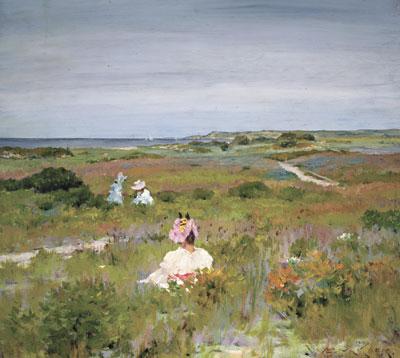A House Tour in Chase’s Footsteps

The Southampton Historical Museum will hold its annual house tour on Saturday at houses throughout Southampton Village and beyond. Now in its fifth year, the tour will include several houses as well as St. Andrew’s Church of the Dunes, the Thomas Halsey Homestead, and the 1708 House inn, which will also serve refreshments.
Of particular note is a house in Shinnecock Hills, designed in 1896 by Katharine Cotheal Budd, a student of William Merritt Chase at his Shinnecock Summer School of Art. Budd’s cottage was part of an enclave of buildings housing the school’s artists that became known as the Art Village. The original design included plots for 15 cottages and a windmill to supply water.
A windmill on the Budd property today has been converted into a guest house, and it is not clear whether it was related to the original windmill, which Cynthia V.A. Schaffner and Lori Zabar described in a 2010 article for Winterthur Portfolio as thatch-covered and likely inspired by the Shinnecock Indian tribe’s traditional wigwams.
In that article, Ms. Schaffner and Ms. Zabar wrote that the school was a natural extension of Chase’s activites at the Art Students League, where he was already working on importing the French tradition of painting outside to the American landscape. Many of his city students followed the artist east to the school, which was one of the first significant summer schools devoted to plein-air painting in the United States, according to the Parrish Art Museum website. It was funded by Samuel L. Parrish and Annie DeCamp Hegeman Porter at the suggestion of Janet Ralston Chase Hoyt. Chase hosted dozens of painters and artistic souls at the school from 1891 to 1902.
The property on this weekend’s tour is set amid the rolling hills from which the area takes its name. The house, while updated, keeps much of the feeling of those early summer colony houses, with diamond-paned windows to catch breezes from all directions, multi-peaked roofs, and a low-slung roofed porch.
Once owned by Francesco Scavullo, the famous fashion photographer, the house’s decor mixing contemporary with antiques so charmed the current owners that they asked to buy all of the interior contents as part of the 1995 sale. The Edelman family, who still own the property, have since updated it but have kept it in a similar spirit.
Other houses on the tour include a mammoth beachfront mansion on the far end of Meadow Lane, set on nine acres between Shinnecock Bay and the Atlantic for sweeping aquatic views. The 17,000-square-foot interior has several wings and viewing perches. In addition to its various sitting rooms and living spaces, there are eight guest bedrooms, two rooms for staff, a home theater, art room, yoga room, and gym. While the exterior is that of a traditional Shingle Style summer cottage, the interior is decorated with mid-century and contemporary European and American furnishings and artwork.
On the opposite end of the spectrum is a more diminutive village cottage in a subdivision made in 1914 by D. Frank Osborne. It is likely the first house built within it. It boasts a four-square plan made popular in the early 20th century by retailers such as Sears Roebuck, which sold them as kits with pre-cut materials that could be constructed on site. A four-square house listed in a 1916 catalog is priced at $1,290.
In its current form, the cedar-shingled cottage has a full front porch with round columns, a side-set main entrance, and double-hung windows. The owner, who is a well-known designer in New York City, was attracted to the house’s light when he purchased the property in 2008. He renovated and restored it, keeping as many historic details intact as possible, including the original windows.
Of the more familiar public spaces, the Thomas Halsey Homestead is the oldest as well as the oldest house in Southampton. It was built around 1666 on the property of one of the area’s original English settlers. It is part of the historical museum properties and has antique tools and furniture inside along with an exhibit devoted to the Shinnecock Indian Nation. The 1708 house may date even further back, and there were certainly dwellings that pre-dated it on the property. Local lore has it that colonists may have met in the basement of the building, which has been restored and is now a boutique hotel. It will be open for tours and will also serve refreshments.
St. Andrew’s Dune Church was originally a life-saving station and was donated as a church in 1879. The non-denominational church and its 11 Tiffany windows managed to survive the 1938 Hurricane, and the building was recently restored and moved to accommodate rising seas. Its summer services are organized by Southampton’s Episcopal church.
The tour lasts from 1 to 4:30 p.m. with a champagne reception following, sponsored by Sant Ambroeus Restaurant. Tickets are $95 in advance and $110 the day of the tour and can be purchased at southamptonhistoricalmuseum.org and at the museum gift shop in the Rogers Mansion.
